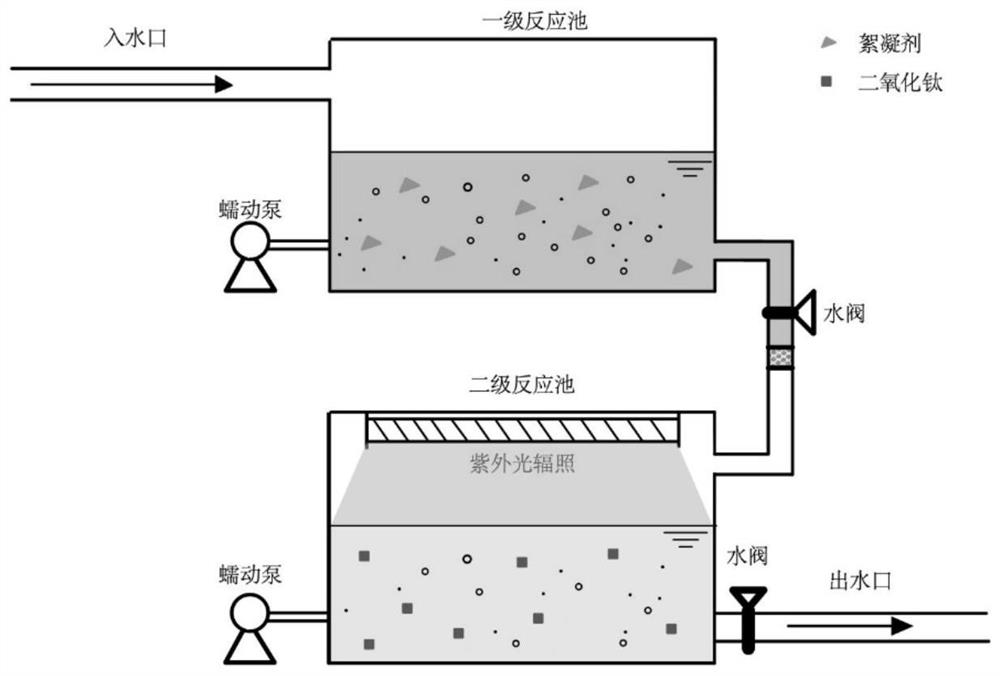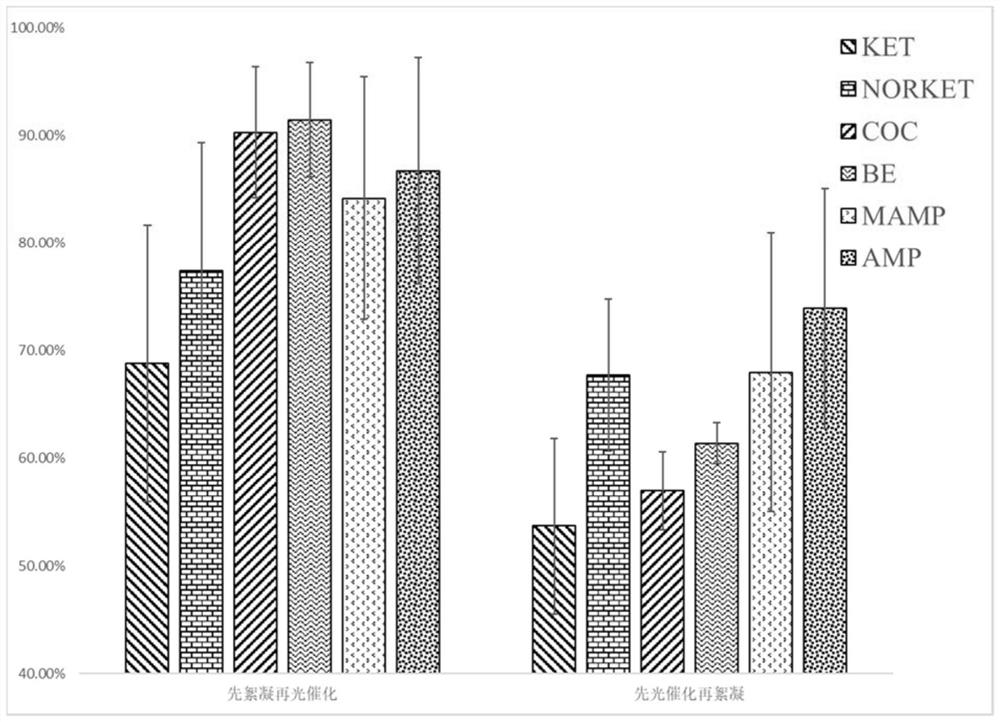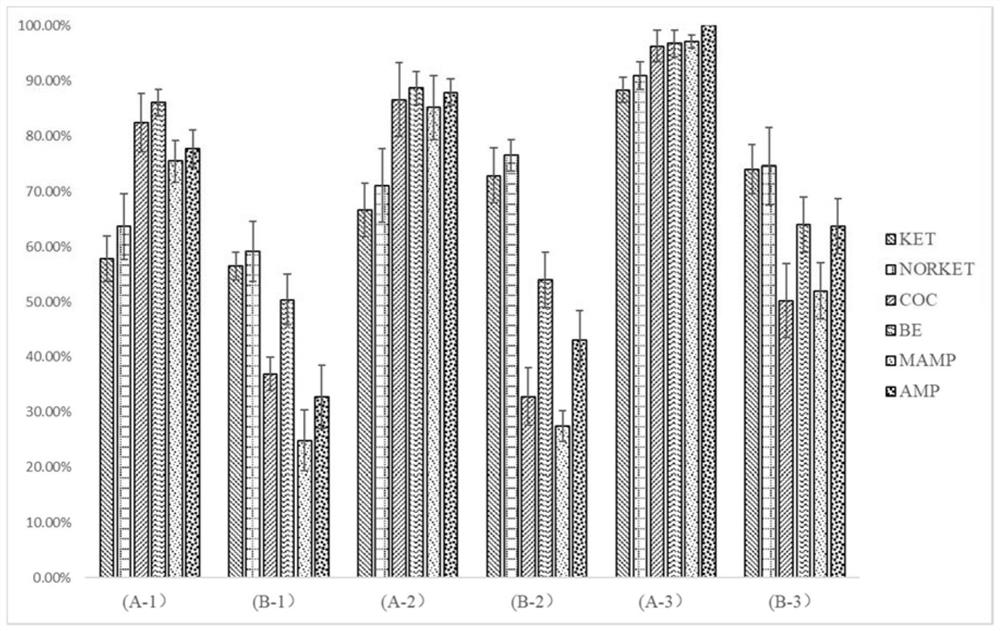Method for removing psychoactive substances in sewage through cooperation of flocculation and photocatalysis
An active material and photocatalytic technology, applied in the fields of flocculation/sedimentation water/sewage treatment, chemical instruments and methods, light water/sewage treatment, etc.
- Summary
- Abstract
- Description
- Claims
- Application Information
AI Technical Summary
Problems solved by technology
Method used
Image
Examples
Embodiment 1
[0080] Example 1. Establishment of analytical method
[0081] 1.1 Standard preparation
[0082] Take the 1 mg / mL stock solution of the standard substances ketamine, norketamine, cocaine, benzoylecgonine, methamphetamine and amphetamine, and use methanol to prepare a 10 μg / mL mixed standard solution for later use.
[0083] 1.2 Substance Abbreviation Comparison Table
[0084] A comparison table of the abbreviations of the psychoactive substances used in the present invention is shown in Table 1 below.
[0085] Table 1
[0086]
[0087]
[0088] 1.3 Analysis and calculation method: single-point quantitative method
[0089] According to the peak area of the target quantitative ion pair in the sample to be tested and the blank added sample, the mass concentration of the target substance in the sample to be tested is calculated according to the following formula.
[0090]
[0091] C The concentration of the target substance in the sample to be tested, in nanogra...
Embodiment 2
[0102] Example 2. Determination of reaction sequence
[0103] Take 3 actual sewage samples and add 10 μg / mL mixed standard solutions of different volumes, respectively, so that the final concentrations are 100 ng / mL, 50 ng / mL, 25 ng / mL, and the numbers are 1, 2, and 3.
[0104] Take 500mL of each of the above 1, 2, and 3 water samples into the primary reaction tank, and then divide them into AB groups, a total of 6 groups, numbered A-1, B-1, A-2, B-2, A -3, B-3. Each group was performed in triplicate.
[0105] Three water samples in group A were added with 5g flocculant (including iron glycinate chelate, manganese sulfate and glucose), and air was aerated to assist flocculation. After 1 hour, filter cotton was placed at the water outlet, and the water valve was opened. Put the water sample into the secondary reaction tank, and add 5g nanometer titanium dioxide powder (particle size 2 / g, crystal form: anatase), aeration is carried out by passing air, and irradiation is carri...
Embodiment 3
[0114] Example 3. Effect of single treatment and co-treatment on removal effect
[0115] After determining the sequence of reactions, this example investigates the effects of single flocculation, single photocatalysis, and flocculation combined with photocatalysis treatment on the removal rates of six target substances in sewage.
[0116] Take the actual sewage samples, add the above 10μg / mL mixed standard solutions respectively, so that the final concentration is 100ng / mL, respectively, take 500mL of the above water samples into the first-level reaction tank, and divide them into ABC groups, each group is divided into three groups in parallel. copy operation.
[0117] Single flocculation: Add 5g of flocculant to the water samples of group A, and aerate the water samples to assist flocculation. After one hour, the water samples were centrifuged at 4,000 rpm for 5 min. Min centrifugation for 5 min, take the supernatant through a 0.22 μm filter, and take 5 μL for LC-MS / MS analy...
PUM
| Property | Measurement | Unit |
|---|---|---|
| wavelength | aaaaa | aaaaa |
| particle diameter | aaaaa | aaaaa |
| specific surface area | aaaaa | aaaaa |
Abstract
Description
Claims
Application Information
 Login to View More
Login to View More - R&D
- Intellectual Property
- Life Sciences
- Materials
- Tech Scout
- Unparalleled Data Quality
- Higher Quality Content
- 60% Fewer Hallucinations
Browse by: Latest US Patents, China's latest patents, Technical Efficacy Thesaurus, Application Domain, Technology Topic, Popular Technical Reports.
© 2025 PatSnap. All rights reserved.Legal|Privacy policy|Modern Slavery Act Transparency Statement|Sitemap|About US| Contact US: help@patsnap.com



